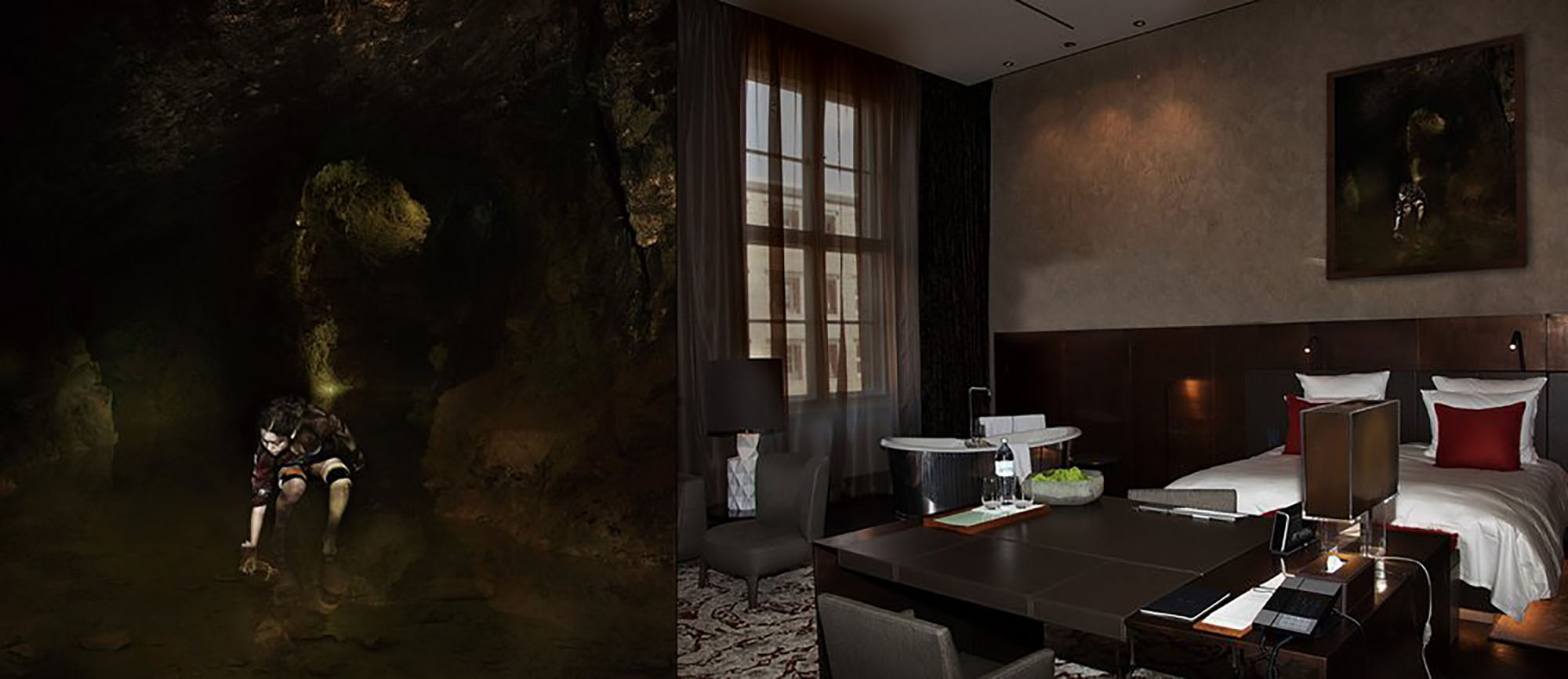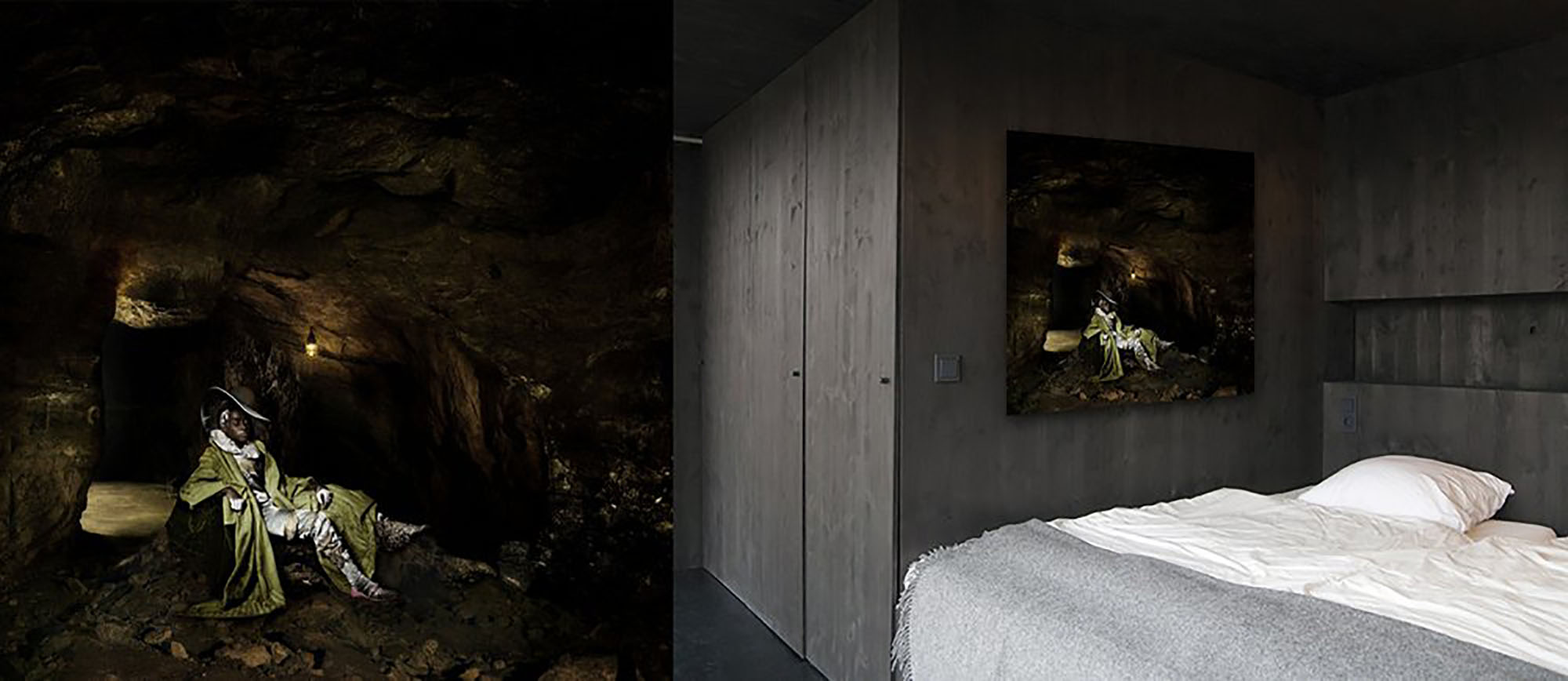UNTER TAGE
unter Tage
Der Besucher wird entführt in eine üppige Schattenwelt, eine die so ganz anders ist als die vertraute ‘lichte’ Wirklichkeit und doch keine entzauberte Traumwelt, eher ein Kontrapunkt zur allgegenwärtigen Hochstilisierung und Idealisierung der Gegenwart.
Zu sehen sind dramatische Szenen vor düsteren kargen Kulissen in morbider Atmosphäre, die die Sündhaftigkeit und Beschränktheit des menschlichen Daseins und den Versuch ihrer Überwindung spiegeln. Jene Protagonisten die ‘Unter Tage’ bevölkern, scheinen zu schweben zwischen hoffnungsvollem Überlebenskampf und apathischer Resignation. Winkhaus Werke geben Zeugnis von immerwährender intensiver Beschäftigung mit den politischen und sozialen Themen unserer Zeit und scharfsinniger Beobachtung ihrer Gesten.Die Künstlerin wagt eine Art Demaskierung der Gesellschaft und unternimmt den Versuch, den Mitspielern im Geiste der Aufklärung den Spiegel vorzuhalten mit dem Ziel die Menschen zur Emanzipation zu beflügeln. Sie thematisiert auf provokante, verstörende und berührende Weise was für ein schrecklicher Ort das Leben doch sein kann, aber vielleicht nicht muss. Das diese Arbeiten eher als malerisches Werk wahrzunehmen sind, ist der bemerkenswerten über die Jahre mittlerweile zur Meisterschaft vorangetriebenen aufwendigen Technik der Künstlerin geschuldet. In langwierigen und anspruchsvollen Produktionsprozess komponiert sie unzählige, vorher separat aufgenommene Einzelbilder unter virtuoser Ausschöpfung der stilistischen Mittel digitaler Bildbearbeitung zu komplexen Gesamtkunstwerken. Dem Sog dieser teilweise bis zur Ekstase gesteigerten Formung der opulenten Bildwelten, die altmeisterlich anmutend, kann sich der Betrachter wohl kaum entziehen.
Text: Silke Arendt
In the last years Winkhaus has been “down the mine” creating her new exhibition series, Unter-Tage: Shot by God. The 14 large-format pictures offer an entrance into a clandestine labyrinth-like landscape of mountain passages. Each scene emerges with a sudden jolt, as if she has flicked on a torch, to reveal to us a cast of strange figures going about their, often dubious, activities. Winkhaus’s work offers testimony to an intense preoccupation with the political and social themes of our age and a shrewd observation of our gestures. Rather than interpreting this world as a strict antithesis to our above ground society, the subterranean caverns reflect it’s hidden internal structure. She ventures a way to demask society and attempts to give each player a moment of self-reflection that spurs them towards emancipation. Light falls with equally clarity on spotless silk shirts, rusty industrial machinery, or a human skull used in a frenzied ritual. Beauty is measured against dirt, violence, corruption and darkness. The challenging stare of a young boy stood before a group of slumped lifeless bodies, a false Goethe reciting disinterestedly swamped by over-sized finery, a statuesque warrioress with bruised knees and make-shift armour surrounded by a disaffected tribe in tattered denim. This is the bloody theatre of mortality. Yet, the viewer is unable to defy the pull of this opulent image-world that reminds one of the old masters of Renaissance and Baroque paintings. This effect is not just a matter of overtly dramatised bodies and gazes, but also of the way that Winkhaus leads the eye, to travel through the image from detail to detail, making us squint to see what lurks in shadowy corners as much as the dramatically lit main-stage. Our roaming eye adopts the immobilised three dimensionality of the movie camera, while texture and colour appear painterly. The rock face at moments blank and cold also shimmers with gold. What the technique of this series amounts to is that the figures, the props and the backgrounds were shot separately and the whole image brought into existence within a projective system other than linear perspective. In two distinct ways Winkhaus has struggled to amplify the content beyond the limits of the photographic medium – a struggle that her natural restlessness, her dissatisfaction with continuing to do something that she can (as saying goes) do only too well, as well as her curiosity about the resources of art that she has left untried. The two ways in which Winkhaus has tried to extend her art are these: she has tried to enrich the visual findings of the eye with a depth of feeling and she has also tried to implicate the eye, thus enriched, into the very scene that it seems to record.
Learning, where this includes wanting to learn, not being afraid to learn, not being afraid to show that one has something to learn, is anyway a big theme in Winkhaus’s work. Unter der Tage thematises in a provocative, unsettling and tangential manner what a worrying place life can be, but perhaps also, need not be.















